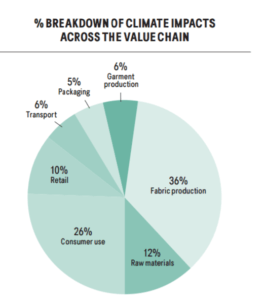Can H&M Make Sustainability Stylish?

H&M experiences the impacts of climate change across the value chain in several ways. Can H&M reduce the footprint of their garments and get the customer involved to help drive change?
Fashion and climate change. Two things that don’t usually go together.
Fact: The $3 trillion global apparel industry accounts for 10% of global carbon emissions. The impact is present across the value chain and the cumulative effect is significant:
Raw materials – Cotton is the world’s largest pesticide-consuming crop, using 11% of all pesticides and 24% of insecticides globally, having severe impacts on soil and water. Cheaper synthetic fibers also emit gasses that are said to be 300x more damaging than CO2. [1]
Production – Making fabrics and subsequent garments has effects on chemical usage, water usage and greenhouse gas emissions. It takes more than 400 lbs. of water just to process one pound of textiles [2]. Producing man-made fibers, like viscose requires pulp from trees which means almost 120 million trees are cut down every year. Often these trees come from ancient or endangered forests [3].
The impact worsens along the chain, but then we get to the consumer. 26% of the carbon emissions in a garment’s life occur at home when it gets washed [4]. And then – Americans throw away 70 lbs. of clothing per person per year [1].
Breakdown of Climate Impacts in a Garment’s Life Cycle [2]
Take a look at H&M’s model – fast fashion. In contrast to traditional retail, their model is to vastly reduce lead times in design, production, and distribution. Retailers like H&M and Zara pump out lower-cost clothing based on current runway trends [5]. Fast fashion means “wear today, tear tomorrow” and remarkably, we now consume almost 400% more clothing than we did 30 years ago [6]. Implication? All the environmental effects in raw materials, production and usage are amplified.
Fast fashion garments (worn less than 5x and kept for ~35 days) produce over 400% more carbon emissions per item per year than regular garments [1]. 400% more consumption, 400% more carbon emissions. The impact is real. What does that mean for H&M?
Cost is key for a company like H&M. Rising costs due to climate change impact how cheap they can get their clothing to the consumer. Fast fashion is competitive and key element of competition is price. Beyond costs, the bigger threat is finding sustainable inputs and a sustainable process that can fuel future growth.
Here’s the key: H&M has power in the value chain and thus, a responsibility to affect change throughout the chain and be the driving force in sustainable style.
So what are they doing?
Raw materials – H&M has set the goal of using cotton only from sustainable sources by 2020. This means grown without chemicals, with less water and even using cotton that’s recycled from old garments.
Production – H&M is working on investing in new technologies to reduce the environmental impact of their processes. H&M recently partnered with the NGO Canopy to engage with suppliers and ensure that they create policies to avoid sourcing fabrics from forests that are ancient or endangered. They are also working on requiring full traceability on man-made fabrics by 2017. Further, they’ve implemented a process to assess each of their supplier factories on sustainability, particularly in factors including energy, chemicals and water usage.
From a consumer standpoint, H&M has introduced a Conscious Collection, a line of clothes where at least 50% of materials are “conscious”, meaning recycled or sustainable (and independently certified as such) [3].
The Conscious Collection [7]
H&M has also introduced a recycling program, encouraging customers to bring in any of their old clothing (from H&M or elsewhere), offering them store discounts to do so [8].
H&M Recycling Program [9]

But they can do more. Every decision from fabric choices to design choices to placement starts and ends with the consumer. H&M needs to educate their consumer and change the way we demand and consume clothes. Customers lately want to know exactly where their food comes from. Clothes should be no different. H&M needs to drive this by increasing visibility and information flow to consumers.
H&M labels their Conscious Collection with a green tag. What this does is make the customer aware that their garment has been produced sustainably. What it doesn’t affect is the 26% of emissions that occur after the garment has been purchased. H&M needs to use the power of their branding, customer loyalty and marketing to change how customers use, re-use and care for their garments. Better labelling and more education in stores would help. Why can’t sales associates talk to customers about sustainable care for their clothes at the register? Marketing not only needs to influence how and what the customer buys, but also what the customer does after purchase.
H&M has done a great job trying to effect change in their value chain but there’s always more to do. Engage the consumer. Educate the consumer. And together, we can drive change.
Word count: 796
[2] https://www.greenbiz.com/article/why-nike-and-mit-see-textiles-material-climate-change
[5] https://www.cit.com/thought-leadership/fast-fashion-garners-fast-growth/
[7] http://therecessionista.com/new-conscious-collection-arrives-hm-sustainable-chic/
[8] http://www.hm.com/us/magazine/culture/h-m-inside/2016/04/this-is-world-recycle-week
[9] http://dearindulgence.blogspot.com/2013/03/h-conscious-garment-recycling-program.html





H&M’s recycling program seems counter-intuitive to its “fast-fashion” model, where the company itself is pushing users to continuously buy new clothes at cheap prices. The company has no incentive of promoting durability and deters healthy behaviors as “repairing” clothes if thorn (it is cheaper to buy a new piece!). Moreover, people who participate in the program have incentives to buy more (new) clothes. On the surface, this feels as a deceiving initiative that hides behind a “environmentally friendly” facade, but actually, is only there to promote sales. It would be great to understand how the “Recycling” initiative closes the loop with other practices that could be truly beneficial for the environment.
I agree with Jean Grey. H&M’s business model – along with the rest of the fast fashion industry – is inherently contradictory to the notion of sustainability. H&M has conditioned many consumers to the idea that you can wear a piece a few times and then discard that item. And, while I agree with Anisa that the company can do more, nearly any action that they pursue is just a bandaid vs. a true solution. H&M will always be driven to sell more items and have their consumers replace their clothes with shocking regularity (an average H&M item is only worn 5 times!). While I appreciate that they are seeking ways to be sustainable, I believe that the model of “fewer, better things” that a company like Cuyana (https://www.cuyana.com/?gclid=CjwKEAiA6YDBBRDwtpTQnYzx5lASJAC57ObMj91memZp8g2wAA_ld9YVWaC8yJ_C9QKbblQ7pi9PBxoCIZPw_wcB) is adopting is more authentic and environmentally conscious.
Apologies in advance for the cynicism, but I agree with the above comments and believe that H&M sustainability initiatives seem very gimmicky and more of a marketing ploy than anything. The idea of encouraging and conditioning consumers to only wear clothing a few times goes against sustainability in every sense of the word. Having a goal to source organic cotton doesn’t even make a dent in the damage they are doing as a result of wasted resources associated with the increasingly massive amounts of clothing that are ending up in the landfill because of H&M’s fast-fashion model. Further, H&M is a leader in the fashion industry, and is causing more company’s to pursue the fast fashion model, resulting in far more indirect wasted resources than directly created by their wasted clothing. I don’t think being slightly less bad is a admirable goal for H&M.